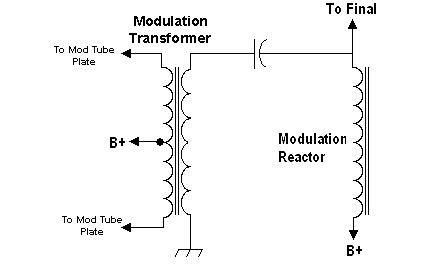|
Modified Heising by Don - K4KYV |
|
The basic “modified” Heising circuit (or the parallel-feed modulator) is shown in figure above. You don’t need tens of microfarads (uF) for the audio coupling condenser in this circuit. The old RCA broadcast transmitters used only a couple of uF, and they are famous for their low frequency response. The reactor needs a minimum of 8 henries of inductance per thousand ohms of modulating impedance. For a given performance level, it is cheaper to use the transformer-reactor combination than to design a transformer capable of carrying the DC to the final. Another way to connect the transformer is to place the coupling capacitor between the cold end of the secondary to ground and connect the hot end directly to the final. This way, once the coupling capacitor is charged, the primary and secondary windings are at a similar DC potential, whereas grounding the secondary directly keeps the full modulator power supply voltage between windings at all times, an unnecessary stress on the insulation between the transformer windings. An additional advantage of using a reactor and returning the mod transformer winding to ground (through the capacitor or directly) is that the audio voltage from the modulator is returned directly to ground instead of through the output filter capacitor in the RF final power supply. The modulation reactor also acts as an additional filter choke in the RF final power supply. This results in reduced hum in the audio, and in the case of a common power supply for modulator and final, less distortion. Since a class-B modulator draws a varying plate current over the audio cycle, peaking as each modulator tube reaches peak plate current, a second harmonic audio component is induced into the output of the modulator power supply. If a common power supply is used and the modulation transformer secondary is returned to ground through the power supply (which is the case when the DC flows through the mod transformer secondary), this harmonic component appears at the modulator output unless the power supply filter capacitor is sufficient to completely return it to ground.\In summary, the parallel-feed modulator circuit with the modulation reactor results in cleaner modulation with less hum and distortion, while reducing the total cost of modulation iron. |
